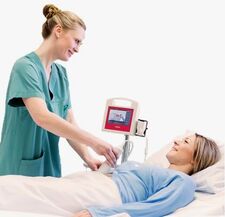Vitacon is the designer and developer of the VitaScan LT, the first fully automatic USB Ultrasound Bladder Scanner. This advanced bladder scanner is designed to calculate bladder volume using real-time ultrasound imaging without the need for sonographer training. We have designed the most portable bladder volume instrument for long-term care, nursing homes, skilled nursing facilities, acute care, emergency departments, surgery centers, and urology clinics.
Reduce Catheterizations...
Reduce Infections
 Click image to schedule an Web Demo
Click image to schedule an Web Demo
The estimated number of hospital-acquired infections (HAIs) in US hospitals exceeds 1.7 million events annually, leading to an estimated 99,000 deaths. Urinary tract infections account for approximately 40% of all HAIs annually. Fully 80% of these hospital-acquired urinary tract infections are attributable to indwelling urethral catheters. If nursing homes are considered along with acute care hospitals, it is estimated that there are more than one million cases of catheter-associated urinary tract infections (CAUTI) annually.
To Cath or Not To Cath...
In the US, up to five million urinary catheters are placed annually. Between 12% and 25% of all hospitalized patients will receive a urinary catheter during their hospital stay, with as many as half not having an appropriate indication.
It is well established that the duration of catheterization is directly related to risk for developing a urinary tract infection. With a catheter in place, the daily risk of developing a urinary tract infection ranges from 3% to 7%. When a catheter remains in place for up to a week, bacteriuria risk increases to 25%; at one month, this risk is nearly 100%. Among those with bacteriuria, 10% will develop symptoms of UTI (fever, dysuria, urgency, frequency, suprapubic tenderness) and up to 3% will further develop bacteremia.
How-to Guide: Prevent Catheter-Associated Urinary Tract Infections. Cambridge, MA: Institute for Healthcare Improvement; 2011. (Available at www.ihi.org).
The most commonly accepted method to determine whether to catheterize is an ultrasound bladder scanning test.
According to a 2002 article in the Journal of America Medical Informatics Association, 2 million patients acquire nosocomial (hospital-acquired) infections during hospital stays annually. These infections result in 19,000 deaths annually. The annual cost to treat these infections is $28-$34 billion.
According to an estimate from the CDC published in 2001, healthcare-associated UTIs resulted in an excess cost to the U.S. healthcare system of more than $400 million annually.
CMS / Tag F315 and Long Term Care Facilities:
CMS regulations and revised Tag F315 mandate that long-term care facilities appropriately assess and treat the specific bladder disorder of UI and decrease the inappropriate use of indwelling urinary catheters.
Synopsis of regulation (F315); three aspects:
1) A resident who does not have an indwelling urinary catheter does not have one inserted unless the resident’s clinical condition demonstrates that it was necessary.
2) The facility provides appropriate treatment and services to prevent urinary tract infections (UTIs)
3) The facility attempts to assist the resident to restore as much normal bladder function as possible
Various factors common to elderly individuals may increase the risk of infection including: …… conditions that cause incontinence, and indwelling urinary catheters. Urinary tract infection (UTI) is one of the most common infections occurring in nursing homes and is often related to an indwelling urinary catheter. The incidence of bacteremia is 40 times greater in individuals with a long term indwelling catheter than in those without one.
A review of the evidence based practice (EBP) literature has determined that any assessment of UI should include the availability of an ultrasound bladder scanner to determine post void residual (PVR) urine amounts
(Centers for Medicare and Medicaid Services [CMS], 2006; Lekan-Rutledge, 2004, 2006; McCliment, 2002; Newman et al., 2005; Sparks et al., 2004)
Non-compliance with Tag F315 can be costly:
Level 4 immediate jeopardy to resident health or safety
Carries fines of $3550 to $10,000 per day. An example of a severity level 4 deficiency is complications resulting from utilization of a urinary appliance without medical justification or extensive failure in multiple areas of urinary incontinence or catheter management.
Level 3 actual harm that is not immediate jeopardy
Carry fines up to $3,000 per day. Examples of this level include failure to provide appropriate catheter care, development of a symptomatic UTI from an unnecessary catheter, failure to assess and manage retention (PVR), decline of failure to improve continence status, and complications due to UI macerations, erosion, embarrassment, and humiliation.
Non-invasive bladder scanning preserves the resident’s dignity, respect, and comfort level:
The use of non-invasive technology that ensures quality and evidence-based clinical practice is necessary for bladder assessment in the extended care setting. Adoption of technology can preserve the resident's dignity and respect, while ensuring the highest level of bladder function.
Newman DK, Gaines T, Snare E Penn Center for Continence and Pelvic Health, Division of Urology, University of Pennsylvania Medical Center, Philadelphia, PA 19104, USA. Journal of Gerontological Nursing [2005, 31(12):33-41; quiz 42-3]
